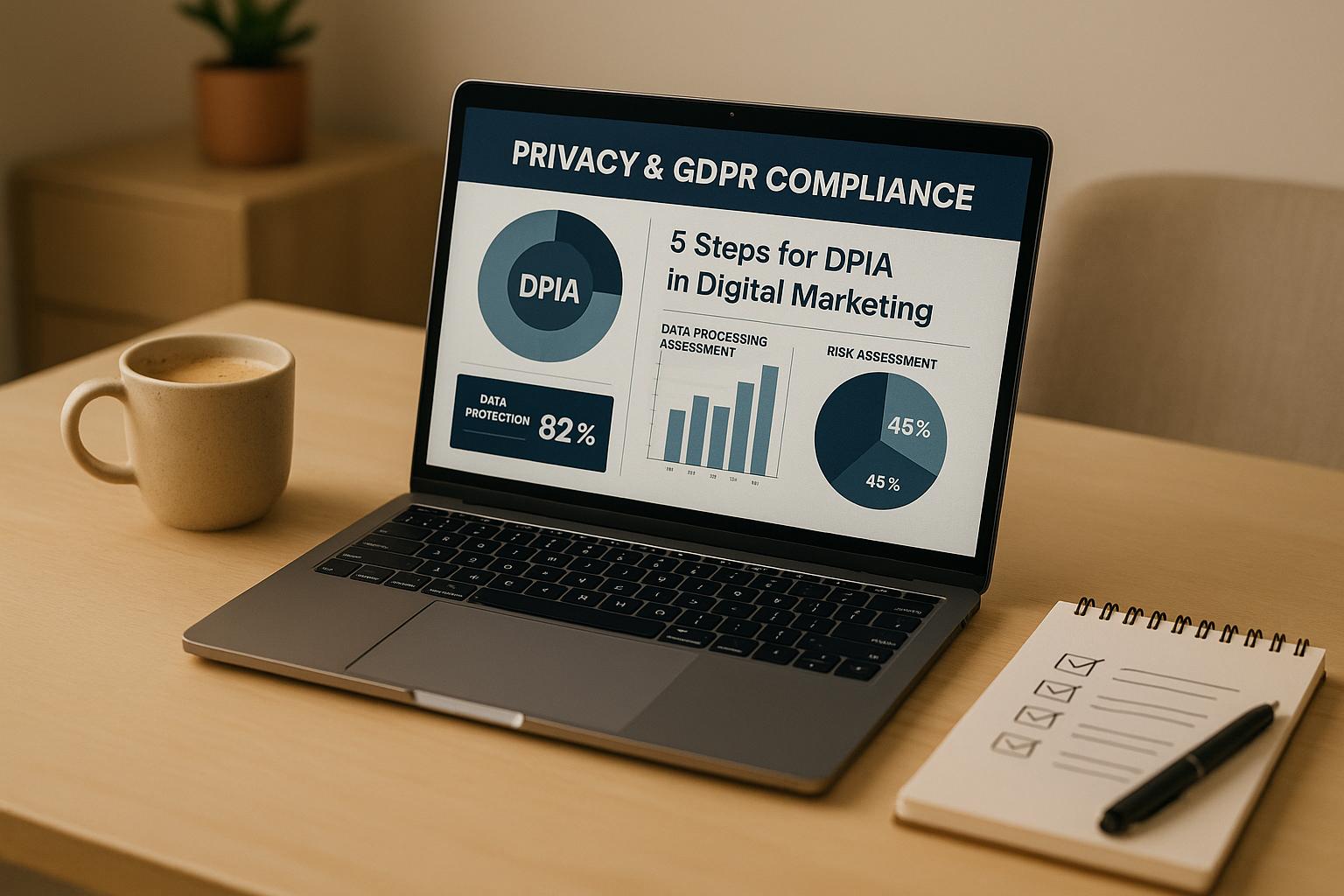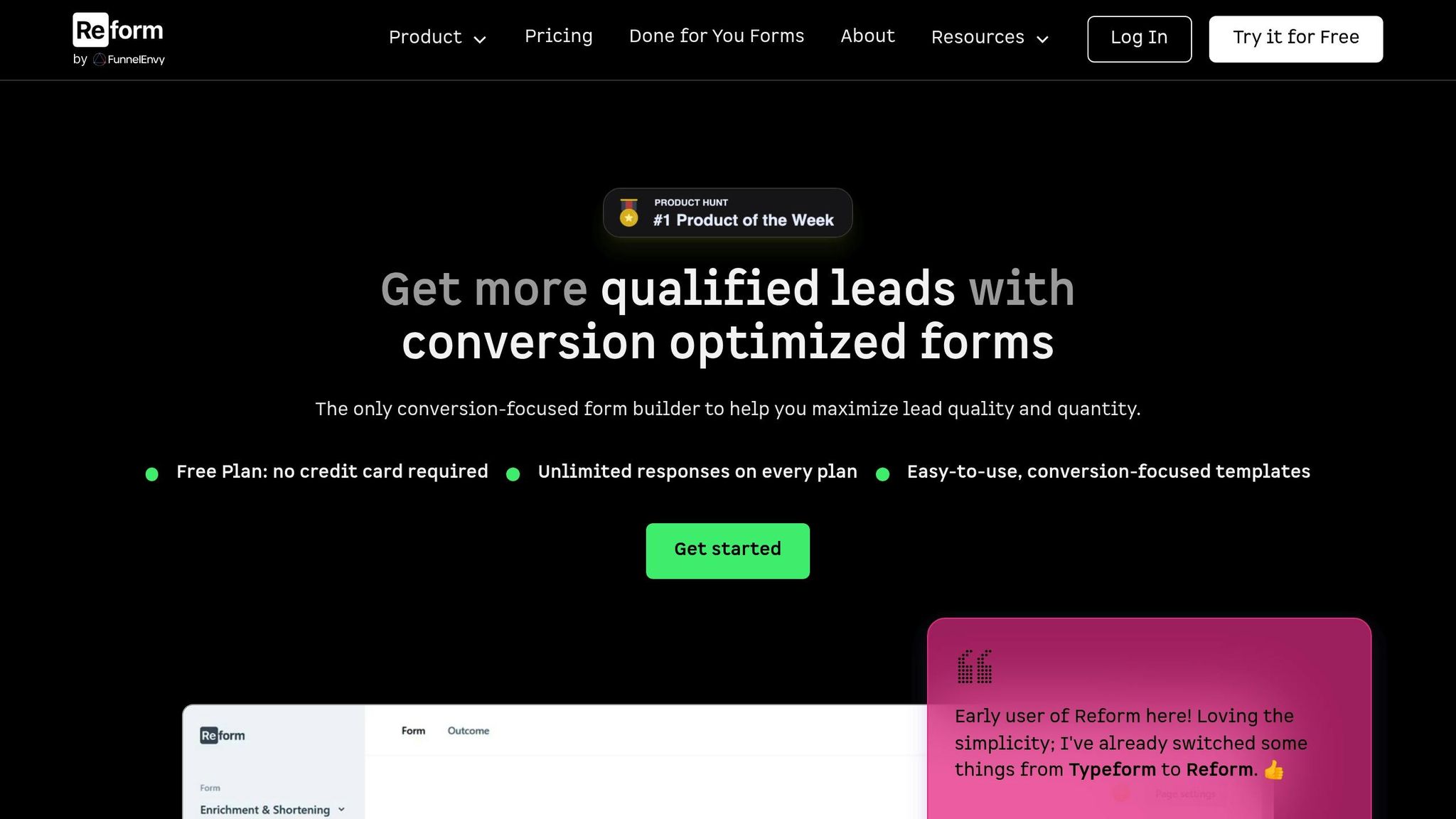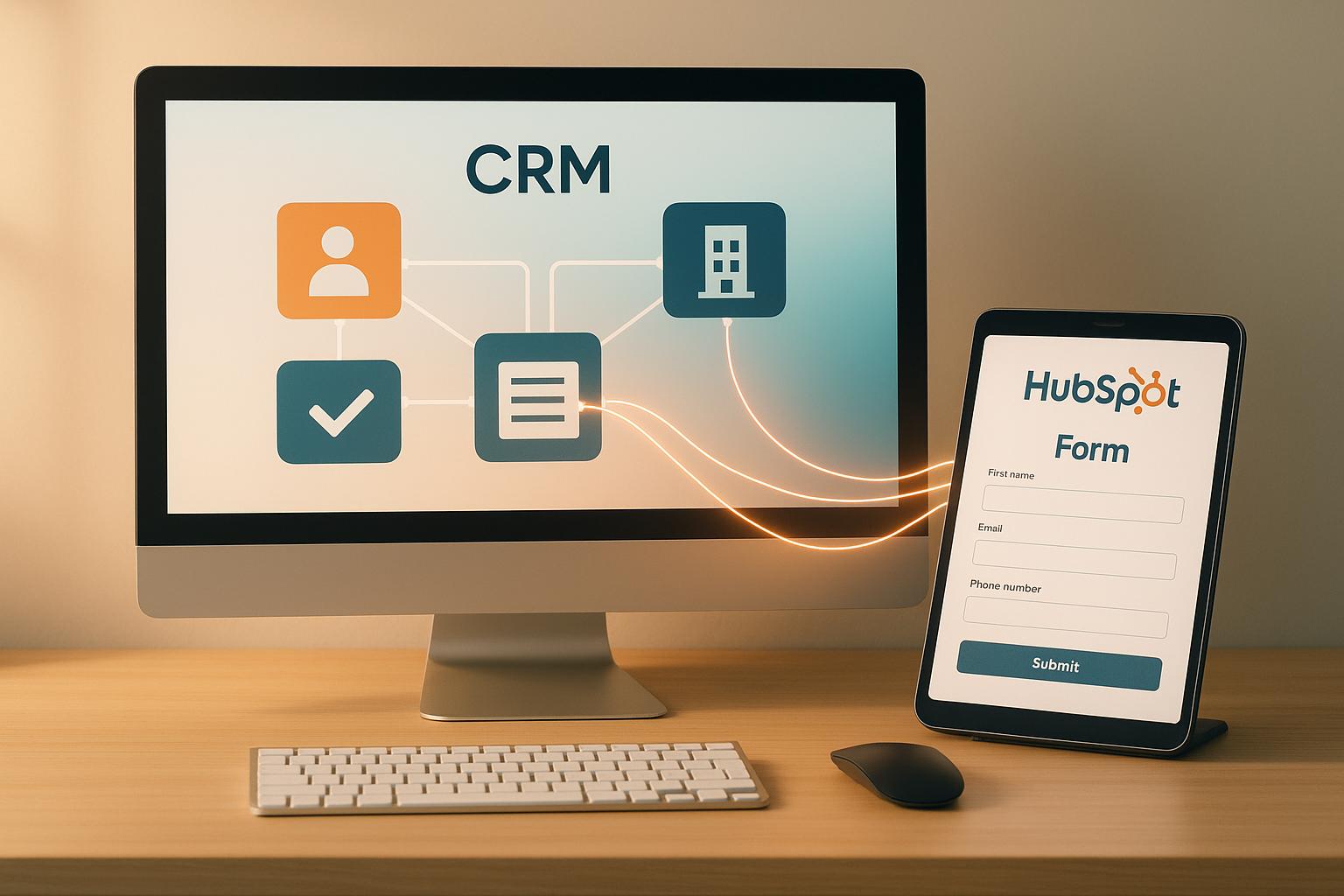5 Steps for DPIA in Digital Marketing

A Data Protection Impact Assessment (DPIA) is a process that helps digital marketers identify and manage privacy risks in data handling. It's required under GDPR for activities that pose a high risk to individuals' rights, such as profiling, automated decision-making, or large-scale data collection. For marketers, DPIAs aren't just about compliance - they're a way to build trust by showing responsible data management.
Here’s a quick breakdown of the 5 steps to conduct a DPIA for digital marketing:
- Document Data Processing Activities: Map out how, where, and why personal data is collected, stored, and used.
- Evaluate Necessity and Proportionality: Ensure every piece of data collected serves a clear purpose and aligns with GDPR's data minimization principle.
- Identify Risks to Individuals: Assess privacy risks, including profiling, lack of transparency, or weak security measures.
- Implement Risk Mitigation Measures: Strengthen data security, refine consent mechanisms, and train teams on privacy practices.
- Document and Review: Keep detailed records of your DPIA and update regularly as tools, campaigns, or regulations change.
GDPR Requirements for DPIA
When is a DPIA Required?
Under GDPR, a Data Protection Impact Assessment (DPIA) is mandatory when data processing is likely to pose a high risk to individuals' rights and freedoms. Specifically, GDPR highlights scenarios like systematic profiling, large-scale use of sensitive data, or extensive public monitoring as automatic triggers for a DPIA (Article 35).
In addition to these explicit cases, the European Data Protection Board (EDPB) has outlined other situations that may indicate a high risk. These include activities like evaluation or scoring, automated decision-making with legal consequences, systematic monitoring, processing sensitive or highly personal data, large-scale data handling, combining datasets, processing data from vulnerable groups, using advanced technologies, and restricting individuals from exercising their rights.
A general rule of thumb is that if at least two of these criteria are met, a DPIA is required. Even when the legal necessity isn’t clear, conducting a DPIA is a prudent choice. It shows due diligence and aligns with best practices, especially in areas like digital marketing, where data handling often meets the thresholds for requiring a DPIA.
"GDPR noncompliance is a significant risk for all companies doing business in the EU. Marketing is the first department one thinks of for GDPR compliance because a lot of personal data is collected for their activities. News headlines are almost always about fines for huge tech platforms, but any noncompliant company is at risk, and penalties have a greater impact on smaller companies, which is something marketers never want to face."
– Adelina Peltea, CMO at Usercentrics
How Digital Marketing Triggers DPIA Requirements
Digital marketing often checks the boxes for high-risk data practices, making DPIAs a frequent requirement. Let’s break down some key activities:
- Behavioral targeting and segmentation: This involves creating detailed customer profiles based on data like browsing habits, purchase history, and demographics. Such extensive profiling typically requires a DPIA.
- Automated marketing decisions: Systems that automatically personalize ads, prioritize leads, or adjust pricing can significantly impact individuals. Examples include lead scoring algorithms, dynamic pricing, and automated campaigns.
- Large-scale data collection: Modern marketing heavily relies on gathering data, whether it’s tracking website visitors, collecting email addresses through lead magnets, or building lookalike audiences. The sheer scale of this data handling often triggers DPIA requirements.
- Matching and combining datasets: Integrating data from multiple sources - like website behavior, email engagement, purchase history, CRM systems, and social media - can escalate the risk level, making a DPIA necessary.
"Increasingly, though, the platforms that many companies rely on for advertising, data, audience access, and more are requiring proof of consent that's in line with GDPR requirements. The noncompliance risk to day-to-day marketing functions, like personalization and retargeting in advertising, can create a much bigger sense of urgency regarding privacy compliance when it could immediately affect revenue and operational stability."
– Adelina Peltea, CMO at Usercentrics
Another common trigger is invisible processing. This happens when personal data is collected indirectly - such as buying data from brokers, using lookalike audience tools, or enriching lead data with third-party information - without the individual being aware. Since this type of data collection lacks direct transparency, it inherently carries higher risks and often requires a DPIA.
How to Conduct a GDPR-Compliant Data Protection Impact Assessment (DPIA) under the GDPR
5 Steps to Conduct a DPIA for Digital Marketing
Conducting a Data Protection Impact Assessment (DPIA) for digital marketing requires a structured approach to address the unique challenges of handling personal data in marketing. These steps translate GDPR requirements into practical actions tailored to your marketing workflows.
Step 1: Document All Data Processing Activities
The first step in a DPIA is creating a detailed record of how personal data is processed within your marketing operations. This involves mapping out all the touchpoints where personal data is collected, stored, or transferred.
Start by identifying every point where personal data enters your system, such as lead forms, tracking pixels, or CRM platforms. For each data source, document the types of information collected - email addresses, phone numbers, IP addresses, browsing behavior, demographic details, or purchase histories.
Track where the data originates. Does it come directly from individuals filling out forms? Is it gathered indirectly through tracking tools? Or is it sourced from third-party providers like social media platforms or data brokers? Then, map how the data flows through your systems - for example, from website forms to your CRM, or from analytics tools to advertising platforms.
Also, document the tools and platforms involved, along with their security features and data retention policies. Finally, ensure you record the legal basis for each data processing activity under GDPR, such as consent, legitimate interest, or contract fulfillment. This comprehensive documentation sets the stage for assessing the necessity and proportionality of your data practices.
Step 2: Check if Data Collection is Needed and Proportional
Once you’ve documented your data flows, evaluate whether each data point you collect is essential and proportionate to your marketing goals. This step ensures compliance with GDPR’s data minimization principle.
Examine each field of data in your systems. For instance, if you’re running B2B campaigns, job titles and company information might be relevant. But if you’re selling consumer products, asking for such details could be unnecessary. Similarly, if your goal is to send a monthly newsletter, collecting extensive behavioral or demographic data might be excessive unless it’s tied to advanced personalization efforts.
Set clear retention policies that align with your marketing needs and privacy obligations. Automate data deletion processes where possible to ensure compliance without manual intervention.
Step 3: Identify Risks to Data Subjects
Now, assess how your data practices might impact individuals’ privacy rights. This step goes beyond technical security to consider broader risks like profiling, automated decision-making, and transparency.
For example, if you use algorithms to segment audiences or personalize content, evaluate how these processes could affect individuals. Are they fair and unbiased? Are they clearly explained to users? Review your security measures, such as encryption and access controls, to address risks like unauthorized access or data breaches in third-party tools.
Transparency is another critical factor. If users don’t understand what data you collect, how it’s used, or how they can exercise their rights, trust erodes, and compliance risks increase. Check whether your privacy notices are clear, your consent mechanisms are easy to navigate, and your processes for handling user requests (like data access or deletion) are efficient.
Finally, assess risks from third-party vendors. Ensure your marketing tools and partners follow strong privacy and security practices, and have proper data processing agreements in place.
Step 4: Put Risk Mitigation Measures in Place
With risks identified, implement measures to reduce or eliminate them while ensuring your marketing remains effective. This involves both technical safeguards and process improvements.
Use tools with built-in privacy protections, such as secure form builders, and enforce robust security measures like encryption, role-based access, and multi-factor authentication. Regular security audits can help you identify vulnerabilities and maintain data protection throughout its lifecycle.
On the process side, establish clear protocols for responding to user requests, such as access, correction, or deletion of data. Train your marketing team on GDPR principles to ensure privacy-conscious practices are embedded in daily workflows.
Consent mechanisms should also be a priority. Enable users to choose how their data is used, make it easy for them to withdraw consent, and maintain accurate records of their preferences.
Step 5: Document Results and Review Safeguards
The final step is to document your DPIA findings and set up regular reviews to keep your practices aligned with GDPR as your marketing evolves.
Create a comprehensive record of your data processing activities, identified risks, mitigation strategies, and any unresolved risks. This documentation not only demonstrates compliance but also serves as a roadmap for ongoing privacy management.
Because marketing practices and technologies change rapidly, schedule regular reviews - quarterly or semi-annually - to reassess your DPIA findings. If you introduce new tools, channels, or campaigns, update your risk assessments to address any new privacy challenges.
Make privacy a core part of your marketing workflows by integrating it into campaign planning, technology evaluations, and decision-making processes. Share DPIA findings with key stakeholders, such as legal teams or senior management, to maintain accountability and ensure privacy remains a collective responsibility.
A DPIA isn’t a one-and-done task. It’s an ongoing effort to balance effective marketing with respect for user privacy and GDPR compliance. By following these steps and committing to regular reviews, you can build trust with your audience while meeting your legal obligations.
sbb-itb-5f36581
Compliance Tools and Best Practices for Lead Generation
Once you’ve outlined the steps of your DPIA (Data Protection Impact Assessment), the next move is choosing the right tools and strategies to ensure compliance in lead generation. GDPR-compliant lead generation requires not just privacy-focused tools but also clear, actionable strategies. The tools you select can simplify compliance efforts and reduce privacy risks, making this decision a key part of your overall DPIA plan.
Reform: A Privacy-First Form Solution

When it comes to GDPR-compliant form builders, Reform stands out as a no-code, privacy-first platform that balances strong data protection with high conversion rates. Its no-code customization allows marketing teams to quickly create forms that comply with privacy regulations, making it easier to integrate privacy measures into your lead generation process.
Reform includes features like spam prevention and email validation to improve data quality while avoiding unnecessary data collection. Its conditional routing feature ensures only relevant data is gathered based on user responses, aligning with the principle of proportional data collection.
The platform also integrates seamlessly with CRM and marketing automation tools, ensuring smooth data flow through your lead generation workflows. With real-time analytics, Reform provides actionable insights to optimize conversion rates - all without compromising user privacy.
For organizations conducting DPIAs, Reform’s multi-step forms offer a smart approach to data collection. These forms allow users to provide basic information first, with additional details requested only when needed. This progressive data collection method enhances the user experience while adhering to GDPR’s data minimization requirements.
While tools like Reform are essential, effective compliance requires more than just technology - it demands a disciplined approach and strong collaboration across teams.
Best Practices for DPIA and Lead Generation
To successfully implement a DPIA, marketing, legal, IT, and data protection teams must work together from the start of any project. This ensures privacy considerations are embedded into campaign planning from day one.
Regular audits are critical to maintaining compliance as your lead generation strategies evolve. During these reviews, assess whether every data point collected serves a legitimate purpose and confirm that your data retention policies remain appropriate.
Transparency is another cornerstone of GDPR compliance. Go beyond generic privacy notices by using simple, conversational language to explain what data you’re collecting and why. Consider using progressive disclosure in your forms - where the purpose of each field is explained as users interact with it - to build trust and secure informed consent.
Managing consent effectively is an ongoing process. Use systems that track consent preferences across all touchpoints, and ensure user choices are respected consistently. If a user withdraws consent, your processes should allow for quick identification and management of their data across all systems.
As your marketing stack grows, vendor due diligence becomes increasingly important. Evaluate each tool’s privacy features, data processing agreements, and security certifications. Keep an updated inventory of all third-party processors and their data handling practices to ensure accountability.
Documentation is another key element. Extend your efforts beyond the initial DPIA by creating templates for privacy impact assessments for new campaigns, standardizing data flow mapping, and maintaining up-to-date records of all processing activities. This structured approach simplifies ongoing compliance and demonstrates your commitment to protecting user privacy.
Lastly, invest in training and awareness programs for your marketing team. Ensure everyone understands GDPR principles and can make privacy-conscious decisions in their daily work. Regular training on topics like consent mechanisms, data subject rights, and secure data handling fosters a culture of privacy throughout your organization.
Conclusion: Key Takeaways from Conducting a DPIA
Conducting a DPIA in digital marketing isn’t just about meeting regulatory requirements - it’s about protecting both your customers and your business. Following a structured five-step process provides a clear path forward: document all data processing activities, ensure data collection is necessary and proportional, identify risks to individuals, implement measures to reduce those risks, and document the results while committing to ongoing reviews.
Each step works as a building block for the next, creating a solid framework that not only ensures compliance but can also give your business an edge. For instance, focusing on proportional data collection (Step 2) results in cleaner datasets and better-quality leads. Similarly, assessing risks (Step 3) helps you steer clear of expensive data breaches and penalties.
Integrating these steps into your workflow doesn’t just enhance compliance - it boosts your marketing efforts. For example, implementing mitigation measures (Step 4) strengthens data security and streamlines your operations, improving overall marketing efficiency.
Tools like Reform make this process easier by embedding compliance into your lead generation workflows. Taking the time to conduct a thorough DPIA isn’t just about following the rules - it’s an investment in building a stronger, more secure, and more effective business.
FAQs
What risks do digital marketers face if they skip a DPIA required under GDPR?
Failing to conduct a Data Protection Impact Assessment (DPIA) when required under GDPR can have serious repercussions. Organizations risk facing fines as high as $22 million or 4% of their global annual revenue - whichever amount is greater. Beyond the financial penalties, they may also face legal challenges and significant damage to their reputation.
Skipping a DPIA leaves businesses more vulnerable to data breaches and regulatory actions. These incidents can undermine customer trust and tarnish your brand’s image. Prioritizing compliance not only helps you avoid penalties but also enhances data security and fosters trust with your audience.
How can digital marketers incorporate DPIA steps into their workflows without disrupting daily operations?
Digital marketers can weave Data Protection Impact Assessment (DPIA) steps into their workflows by embedding privacy considerations directly into their processes. One way to do this is by applying privacy-by-design principles, which make data protection a built-in part of every campaign right from the start. Using project management tools or workflow systems to incorporate DPIA tasks can help teams stay on top of compliance without making things overly complicated.
Automation tools are another great way to streamline DPIA efforts. They cut down on manual work, making it easier to handle compliance tasks quickly and accurately. Additionally, providing your team with proper training ensures everyone knows how to handle these steps without disrupting ongoing campaigns. This way, you can keep your campaigns running smoothly while staying committed to data protection and GDPR compliance.
What are some effective ways to reduce privacy risks in digital marketing activities?
To address privacy risks in digital marketing, businesses can take a few essential steps to safeguard sensitive information. One crucial measure is encrypting data during both transmission and storage, which helps shield it from unauthorized access. Additionally, limiting access through well-defined permissions ensures that only authorized team members handle sensitive data.
Conducting regular security audits is another effective way to uncover potential vulnerabilities in your systems. Pair this with employee training on best practices for data privacy, and your team will be better equipped to manage information responsibly. These efforts not only help you meet privacy regulations but also show your audience that you’re serious about protecting their data, fostering trust and confidence in your brand.
Related posts
Get new content delivered straight to your inbox

The Response
Updates on the Reform platform, insights on optimizing conversion rates, and tips to craft forms that convert.
Drive real results with form optimizations
Tested across hundreds of experiments, our strategies deliver a 215% lift in qualified leads for B2B and SaaS companies.





